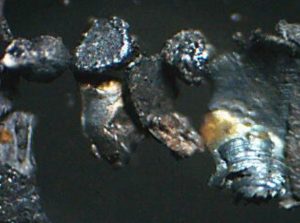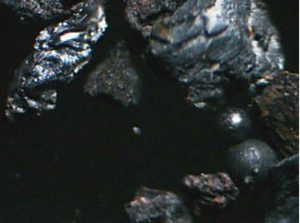Acid Resistant Ferromagnetic Material

Upon poking and prodding at the powders we produce, we decided to use a strong magnet to determine how much material we could extract from the untreated detonation byproducts. Surprisingly, magnetic separation extracted dark grey powder that retains its magnetic charge for a considerable time. This material represents about 5% to 10% of the powder and tends to be larger than 50 μm. Depending on the detonation formulation, some of these powders are acid resistant against concentrated nitric and hydrochloric acids.
This material is typically observed as a combination of metallic-appearing pieces and highly spheroidal ones. The idea that we can produce tiny spheres of an unknown

material was intriguing, so we used a smooth flat surface with a slight incline to separate the spheres from the remaining material. Interestingly, this approach worked very well and we were able to concentrate a large number of tiny spheres.

We performed ICP analysis on a sample and was surprised to learn that the material is a unique alloy of Iron (29.2%), Magnesium (6.8%), Aluminum (0.42%), Calcium (0.33%) and silicon (0.2%). We did not use aluminum or silicon in the Mg-35 detonations, which leads us to speculate how these elements could have accumulated into a seemingly metallic material that was created through CDP detonation.
We placed one sample of dark ferromagnetic powder on a red-hot heating element, which caused the material to burst into orange flames, leaving behind only a small amount of white dust. We suspect that the powder may therefore be largely carbonaceous.
ICP analysis could only shed light on about 40% of the sample’s composition. This implies that the remaining 60% must be a combination of carbon, oxygen and possibly elements that sit outside of the common list of elements that this testing method uses.

In one series of detonation tests we produced an alternative ferromagnetic material that we have not yet performed elemental analysis on. In this case, the material appears to be crystalline and microscopy reveals the crystals are mottled with dark regions that we have theorized to be the magnetically responsive portion.
Acid resistant metallically-doped ferromagnetic graphite would be a great addition to our growing portfolio of possible products. More work needs to be done with all of these remarkable materials.